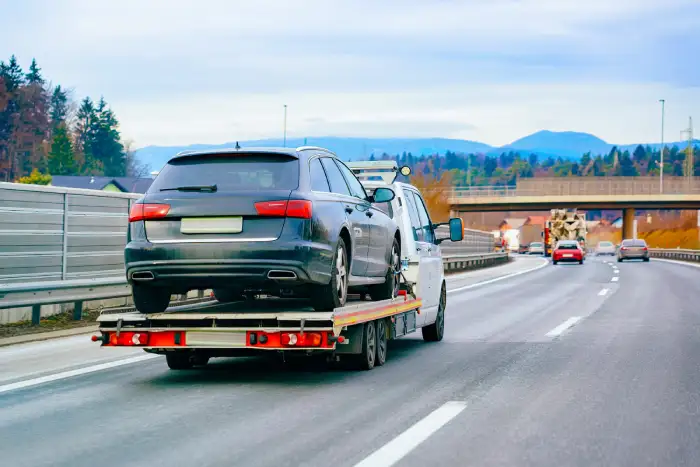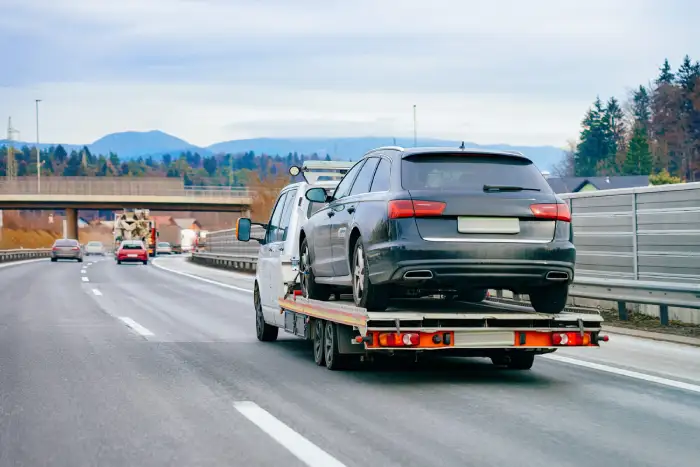Are you planning a long road trip but worried about your car breaking down in the middle of nowhere? Or do you need to transport a car to a different city but don’t want to spend a fortune on a professional towing service?
Whatever your reason, towing a car long distance can seem like a complex task, but there are ways to make it easier.
To begin towing a car long distances, you need to know the right hauling method for your situation and the necessary equipment. Then prepare both vehicles, secure them onto the tow vehicle, and of course practice safe driving.
During transport, it’s important to make regular stops and monitor the towed car in case any issues arise. And being prepared for any emergency is crucial when towing a vehicle long distance.
Now we will discuss these steps that you need to follow when towing a car long distance, so keep reading.
Steps on How to Tow a Car Long Distance

Towing a car over a long distance requires careful planning and the right equipment. Here are the steps to tow a car long distance:
- Step 01: Determine the appropriate towing method
- Step 02: Gather the necessary equipment
- Step 03: Prepare the vehicles
- Step 04: Secure the vehicles
- Step 05: Practice safe driving
- Step 06: Make regular stops
- Step 07: Monitor the towed vehicle
- Step 08: Be prepared for emergencies
Step 01: Determine the Appropriate Towing Method
Choosing the appropriate method is crucial when preparing to tow your vehicle for a long distance.
Flatbed towing is the safest and easiest option for covering significant distances. It entails loading your entire car onto a flatbed trailer and keeping all four wheels off the ground to prevent harm to your tires and suspension.
Alternatively, dolly towing and tow bar towing cost less in comparison. Dolly towing involves putting together a tow dolly and positioning the towed vehicle’s front wheels onto it. This approach is more appropriate for small cars, SUVs, and vehicles with front-wheel drive.
In contrast, tow bar towing uses a solid bar to fasten both vehicles. It’s critical to note that this technique is best used for manual transmission cars. If performed incorrectly, this method can damage the transmission of an automatic vehicle.
Step 02: Gather the Necessary Equipment
Now it’s time to get all the gear you need for the chosen towing method.
For flatbed towing, you’ll need to find a suitable flatbed trailer compatible with your vehicle’s weight and dimensions. You’ll also need straps or chains to secure the car to the trailer.
Make sure to use high-quality straps or chains that are strong enough to keep the car in place during transport. If you’ve decided to use a tow dolly, you must find one compatible with your car’s weight and dimensions.
You can rent tow dollies from many automotive rental companies, but make sure to check the towing capacity and compatibility before you rent. The tow dolly and car must be properly secured with straps or chains to your towing vehicle.
Step 03: Prepare the Vehicles
Let’s prepare the vehicles for the journey by checking their overall health and ensuring that all necessary components are in working order.
Start by inspecting both vehicles’ tire pressure, fluid levels, brakes, lights, and any other essential components. Make sure everything is in good working condition before you hit the road.
Step 04: Secure the Vehicles
Ensure your vehicles are safely connected and won’t come loose during your trip, giving you peace of mind as you hit the road. Depending on your method, use straps, chains, or safety cables to firmly connect the two vehicles.
Double-check all attachments to ensure they’re secure and won’t come loose during the journey. You don’t want to find yourself in a dangerous situation where your towed vehicle becomes separated from your towing vehicle.
Step 05: Practice Safe Driving
Remember to drive cautiously as you hit the road with your securely connected vehicles. Take turns and corners wider than usual to accommodate the extended length of the towing combination. Allow for increased stopping distances to ensure a smooth and safe journey for you and your precious cargo.
Keep in mind that towing a car will affect the handling and braking of the towing vehicle. So, maintaining a safe speed and following all traffic rules and regulations is crucial. Also, staying alert and focused while driving long distances is important.
Step 06: Make Regular Stops
Now that you’re driving safely, it’s time to focus on making regular stops during your long-distance tow. Taking breaks every couple of hours is crucial to preventing driver fatigue and ensuring the safety of your vehicle and the one you’re towing.
When you stop, take the opportunity to stretch your legs, check the connections, and make sure everything is secure. It’s easy to think you can power through a long drive without stopping, but it’s not worth the risk.
Step 07: Monitor the Towed Vehicle
As you’re driving the towing vehicle, watch the towed vehicle’s behavior throughout the journey. Look at the rearview mirrors regularly to check for any indications of swaying, shifting, or other damage.
Identifying these issues could highlight problems with the tow hitch, tires, or suspension. Ignoring these things could lead to further damage or accidents.
Step 08: Be Prepared for Emergencies
It’s crucial to plan for unexpected situations while traveling with your vehicle, so ensure you always have an emergency kit on hand. Your kit should contain essential items such as a first aid kit, spare tire, jack, lug wrench, basic tools, and a flashlight.
These readily available items can help you handle minor issues such as changing a tire or fixing a minor mechanical problem. In addition to having an emergency kit, you should also have contact information for roadside assistance or towing services.
If you’re uncertain about the process of fixing any problem to start your ride, seeking advice or assistance from a professional towing service is recommended. Lastly, be sure to keep your cell phone in case of emergencies.
Set Sail with Confidence: Navigate Long-Distance Towing Like a Pro

Now you better understand how to tow a vehicle long distance. With these steps, you can now confidently tow your car to any destination without any hassle.
Set appropriate safety measures, ensure both vehicles are prepared for the journey, and practice safe driving. Most importantly, be prepared for any emergencies along the way.
Just like a captain navigating through rough waters, you can steer your car to safety. Imagine yourself as a skilled sailor, confidently steering your car through any obstacle that comes your way.
With determination and the knowledge you’ve gained, you can conquer any challenge that may arise during your long-distance tow. So, go ahead and hit the road with confidence.
